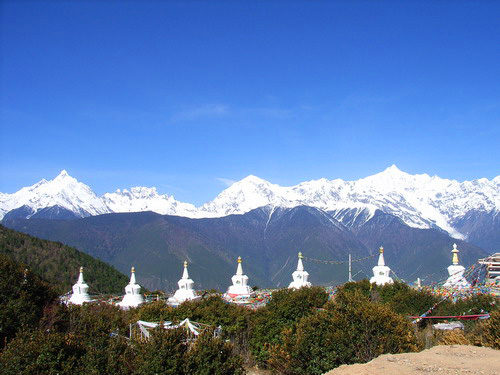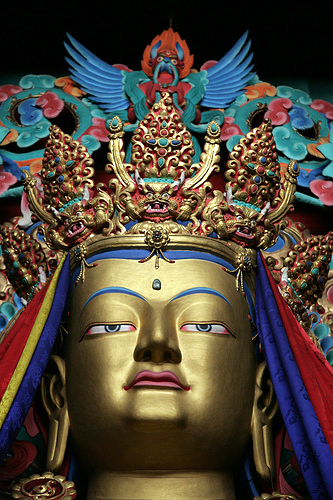|
Kawagebo
Kawa Garbo or Khawa Karpo (; also transcribed as Kawadgarbo, Khawakarpo, Moirig Kawagarbo, Kawa Karpo or Kha-Kar-Po), as it is known by local residents and pilgrims, or Kawagebo Peak (), is the highest mountain in the Chinese province of Yunnan. It is located on the border between Dêqên County, Yunnan, and the counties of Zogang and Zayü of the Tibet Autonomous Region. It rises about west of Shengping (升平镇), the seat of Dêqên County, which lies on China National Highway 214. What is now Dêqên County has been part of Yunnan since the 1720s, when the current border with Tibet was established by the early Qing Dynasty. Kawagarbo is one of the most sacred peaks in the Tibetan world Keith Dowman. 1997. The Sacred Life of Tibet. San Francisco, California, USA: Thorsons. and is often referred to as Nyainqênkawagarbo to show its sacredness and avoid ambiguousness with the other Kawagarbo in the Anung-Derung-speaking Gongshan County. Geography Kawa Karpo is the high ... [...More Info...] [...Related Items...] OR: [Wikipedia] [Google] [Baidu] |
Meili Xue Shan
Meili Snow Mountains ( zh, c=梅里雪山, p=Méilǐ Xuěshān), Mainri () or Minling Snow Mountains () is a mountain range in the China, Chinese Provinces of China, province of Yunnan. It lies close to the northwestern boundary of the province and is bounded by the Salween River, Nujiang river on the west and the Mekong, Lancang River on the east. The Meili are subrange of the larger Nu Mountains, themselves a constituent range of the Hengduan Mountains, Hengduan group. The crest of the range rises to over 6,000 metres (20,000 ft) above sea level, making for impressive prominence over the river valleys to the east and west, which are between 1,500 metres (4,900 ft) and 1,900 metres (6,200 ft) in elevation. The highest peak is Kawagebo, Kawagarbo, which rises to 6,740 metres (22,110 ft). Kawagarbo is considered sacred for Tibetan Buddhists. Other significant peaks include Mianzimu, Cogar Laka and Jiariren-an. Because of restrictions and dangerous conditions, ... [...More Info...] [...Related Items...] OR: [Wikipedia] [Google] [Baidu] |
Yunnan
Yunnan; is an inland Provinces of China, province in Southwestern China. The province spans approximately and has a population of 47.2 million (as of 2020). The capital of the province is Kunming. The province borders the Chinese provinces of Guizhou, Sichuan, Autonomous regions of China, autonomous regions of Guangxi and Tibet Autonomous Region, Tibet, as well as Southeast Asian countries Myanmar (Burma), Vietnam, and Laos. Yunnan is China's fourth least developed province based on disposable income per capita in 2014. Yunnan is situated in a mountainous area, with high elevations in the Northwest and low elevations in the Southeast. Most of the population lives in the eastern part of the province. In the west, the altitude can vary from the mountain peaks to river valleys as much as . Yunnan is rich in natural resources and has the largest diversity of plant life in China. Of the approximately 30,000 species of Vascular plant, higher plants in China, Yunnan has perhaps 17, ... [...More Info...] [...Related Items...] OR: [Wikipedia] [Google] [Baidu] |
Hengduan Shan
The Hengduan Mountains () are a group of mountain ranges in southwest China, southwest China that connect the southeast portions of the Tibetan Plateau with the Yunnan–Guizhou Plateau. The Hengduan Mountains are primarily large north-south mountain ranges that effectively separate lowlands in northern Myanmar from the lowlands of the Sichuan Basin. These ranges are characterized by significant vertical relief originating from the Indian subcontinent's collision with the Eurasian Plate, and further carved out by the major rivers draining the eastern Tibetan Plateau. These rivers, the Yangtze, Mekong, and Salween, are recognized today as the Three Parallel Rivers of Yunnan Protected Areas, Three Parallel Rivers UNESCO World Heritage Site. The Hengduan Mountains cover much of western present-day Sichuan province as well as the northwestern portions of Yunnan, the easternmost section of the Tibet Autonomous Region, and touching upon parts of southern Qinghai. Additionally, som ... [...More Info...] [...Related Items...] OR: [Wikipedia] [Google] [Baidu] |
International Herald Tribune
The ''International Herald Tribune'' (''IHT'') was a daily English-language newspaper published in Paris, France, for international English-speaking readers. It published under the name ''International Herald Tribune'' starting in 1967, but its origins as an international newspaper trace back to 1887. Sold in over 160 countries, the ''International Herald Tribune'' produced a large amount of content until it became the second incarnation of ''The International New York Times'' in 2013, 10 years after The New York Times Company became its sole owner. Early years In 1887, James Gordon Bennett Jr. created a Paris edition of his newspaper the '' New York Herald'' with offices at 49, avenue de l'Opéra. He called it the ''Paris Herald''. When Bennett Jr. died, the Herald and its Paris edition came under the control of Frank Munsey. In 1924, Munsey sold the paper to the family of Ogden Reid, owners of the '' New-York Tribune'', creating the '' New York Herald Tribune'', while t ... [...More Info...] [...Related Items...] OR: [Wikipedia] [Google] [Baidu] |
Mekong
The Mekong or Mekong River ( , ) is a transboundary river in East Asia and Southeast Asia. It is the world's twelfth-longest river and the third-longest in Asia with an estimated length of and a drainage area of , discharging of water annually. From its headwaters in the Tibetan Plateau, the river runs through Southwest China (where it is officially called the Lancang River), Myanmar, Laos, Thailand, Cambodia, and southern Vietnam. The extreme seasonal variations in flow and the presence of rapids and waterfalls in the Mekong make navigation difficult, though the river remains a major trade route between Tibet and Southeast Asia. The construction of hydroelectric dams along the Mekong in the 2000s through the 2020s has caused serious problems for the river's ecosystem, including the exacerbation of drought. Names The Mekong was originally called ''Mae Nam Khong'' from a contracted form of Kra-Dai shortened to ''Mae Khong''. In Thai and Lao, ''Mae Nam'' ("Mother ... [...More Info...] [...Related Items...] OR: [Wikipedia] [Google] [Baidu] |
Monsoon
A monsoon () is traditionally a seasonal reversing wind accompanied by corresponding changes in precipitation but is now used to describe seasonal changes in Atmosphere of Earth, atmospheric circulation and precipitation associated with annual latitudinal oscillation of the Intertropical Convergence Zone (ITCZ) between its limits to the north and south of the equator. Usually, the term monsoon is used to refer to the Wet season, rainy phase of a seasonally changing pattern, although technically there is also a dry phase. The term is also sometimes used to describe locally heavy but short-term rains. The major monsoon systems of the world consist of the Monsoon#Africa (West African and Southeast African), West African, Asian–Australian monsoon, Australian, the North American monsoon, North American, and South American monsoons. The term was first Glossary of the British Raj, used in English in British India and neighboring countries to refer to the big seasonal winds blowin ... [...More Info...] [...Related Items...] OR: [Wikipedia] [Google] [Baidu] |
Tibetan Buddhism
Tibetan Buddhism is a form of Buddhism practiced in Tibet, Bhutan and Mongolia. It also has a sizable number of adherents in the areas surrounding the Himalayas, including the Indian regions of Ladakh, Gorkhaland Territorial Administration, Darjeeling, Sikkim, and Arunachal Pradesh, as well as in Nepal. Smaller groups of practitioners can be found in Central Asia, some regions of China such as Northeast China, Xinjiang, Inner Mongolia and some regions of Russia, such as Tuva, Buryatia, and Kalmykia. Tibetan Buddhism evolved as a form of Mahayana, Mahāyāna Buddhism stemming from the latest stages of Indian Buddhism (which included many Vajrayana, Vajrayāna elements). It thus preserves many Indian Buddhist Tantra, tantric practices of the Gupta Empire, post-Gupta Medieval India, early medieval period (500–1200 CE), along with numerous native Tibetan developments. In the pre-modern era, Tibetan Buddhism spread outside of Tibet primarily due to the influence of the Mongol Emp ... [...More Info...] [...Related Items...] OR: [Wikipedia] [Google] [Baidu] |
Yunnan People's Press
Yunnan People's Publishing House () is a publishing company based in Kunming, Yunnan, China China, officially the People's Republic of China (PRC), is a country in East Asia. With population of China, a population exceeding 1.4 billion, it is the list of countries by population (United Nations), second-most populous country after ..., established on December 25, 1950. It is the only general publishing company of Yunnan Province. References External links * Book publishing companies of China Publishing companies established in 1950 Companies based in Kunming {{China-company-stub ... [...More Info...] [...Related Items...] OR: [Wikipedia] [Google] [Baidu] |
Gelug
file:DalaiLama0054 tiny.jpg, 240px, 14th Dalai Lama, The 14th Dalai Lama (center), the most influential figure of the contemporary Gelug tradition, at the 2003 Kalachakra ceremony, Bodh Gaya, Bodhgaya (India) The Gelug (, also Geluk; 'virtuous')Kay, David N. (2007). ''Tibetan and Zen Buddhism in Britain: Transplantation, Development and Adaptation,'' p. 39. Routledge. is the newest of the four major schools of Tibetan Buddhism. It was founded by Je Tsongkhapa (1357–1419), a Tibetan people, Tibetan philosopher, Vajrayana, tantric yogi and lama and further expanded and developed by his disciples (such as Khedrup Gelek Pelzang, 1st Panchen Lama, Khedrup Je, Gyaltsab Je, Gyaltsap Je, Dulzin Drakpa Gyaltsen, and 1st Dalai Lama, Gendün Drubpa). The Gelug school is alternatively known as Kadam (''bKa’-gdams gsar-pa''), since it sees itself as a continuation of the Kadam (Tibetan Buddhism), Kadam tradition of Atiśa, Atisha (c. 11th century). The school of New Kadam, or New Kadampa ... [...More Info...] [...Related Items...] OR: [Wikipedia] [Google] [Baidu] |
Bön
Bon or Bön (), also known as Yungdrung Bon (, ), is the indigenous Tibetan religion which shares many similarities and influences with Tibetan Buddhism.Samuel 2012, pp. 220–221. It initially developed in the tenth and eleventh centuries but retains elements from earlier Tibetan religious traditions.Kvaerne 1996, pp. 9–10. Bon is a significant minority religion in Tibet, especially in the east, as well as in the surrounding Himalayan regions. The relationship between Bon and Tibetan Buddhism has been a subject of debate. According to the modern scholar Geoffrey Samuel, while Bon is "essentially a variant of Tibetan Buddhism" with many resemblances to Nyingma, it also preserves some genuinely ancient pre-Buddhist elements. David Snellgrove likewise sees Bon as a form of Buddhism, albeit a heterodox kind.Powers 2007, pp. 500–501 Similarly, John Powers writes that "historical evidence indicates that Bön only developed as a self-conscious religious system under the in ... [...More Info...] [...Related Items...] OR: [Wikipedia] [Google] [Baidu] |
Myanmar
Myanmar, officially the Republic of the Union of Myanmar; and also referred to as Burma (the official English name until 1989), is a country in northwest Southeast Asia. It is the largest country by area in Mainland Southeast Asia and has a population of about 55 million. It is bordered by India and Bangladesh to its northwest, China to its northeast, Laos and Thailand to its east and southeast, and the Andaman Sea and the Bay of Bengal to its south and southwest. The country's capital city is Naypyidaw, and its largest city is Yangon (formerly Rangoon). Early civilisations in the area included the Tibeto-Burman-speaking Pyu city-states in Upper Myanmar and the Mon kingdoms in Lower Myanmar. In the 9th century, the Bamar people entered the upper Irrawaddy River, Irrawaddy valley, and following the establishment of the Pagan Kingdom in the 1050s, the Burmese language and Culture of Myanmar, culture and Buddhism in Myanmar, Theravada Buddhism slowly became dominant in the co ... [...More Info...] [...Related Items...] OR: [Wikipedia] [Google] [Baidu] |








